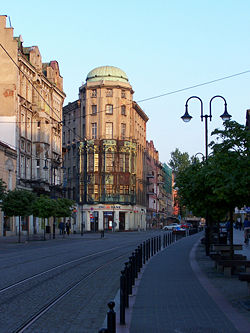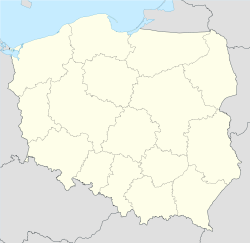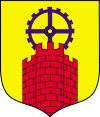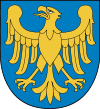Zabrze
| Zabrze | |||
 |
|||
|
|||
 Zabrze
|
|||
| Coordinates: | |||
| Country | |||
|---|---|---|---|
| Voivodeship | Silesian | ||
| County | city county | ||
| Established | thirteenth century | ||
| Town rights | 1922 | ||
| Government | |||
| - Mayor | Małgorzata Mańka-Szulik | ||
| Area | |||
| - City | 80.47 km² (31.1 sq mi) | ||
| Population (2006) | |||
| - City | 190,610 | ||
| - Density | 2,368.7/km² (6,134.9/sq mi) | ||
| - Metro | 3,487,000 | ||
| Time zone | CET (UTC+1) | ||
| - Summer (DST) | CEST (UTC+2) | ||
| Postal code | 41-800 to 41-820 | ||
| Area code(s) | +48 32 | ||
| Car plates | SZ | ||
| Website: http://www.zabrze.pl/ | |||
Zabrze [ˈzabʐɛ] (![]() listen) (German: Hindenburg O.S. from 1915-45, Zabrze before 1915) is a city in southern Poland with 194,041 inhabitants (2004). Zabrze is part of the Upper Silesian Metropolitan Union, the largest legally-recognized urban entity in Poland with a population of 2.2 million. The population of the urban area is 3,487,000 (2004). Zabrze is situated in the Silesian Voivodship (since 1999); previously, it was in Katowice Voivodship (1975-1998).
listen) (German: Hindenburg O.S. from 1915-45, Zabrze before 1915) is a city in southern Poland with 194,041 inhabitants (2004). Zabrze is part of the Upper Silesian Metropolitan Union, the largest legally-recognized urban entity in Poland with a population of 2.2 million. The population of the urban area is 3,487,000 (2004). Zabrze is situated in the Silesian Voivodship (since 1999); previously, it was in Katowice Voivodship (1975-1998).
Contents |
History
Biskupice (Biskupitz), which is now a Zabrze subdivision, was first mentioned in 1243 as Biscupici dicitur cirka Bitom. Zabrze (later Old Zabrze) was mentioned in 1295-1305 as Sadbre sive Cunczindorf. Beginning in the Late Middle Ages, the local Silesian Piast dukes invited German settlers to the territory resulting in increasing German settlement of the area. Zabrze was inherited by the Habsburg Monarchy of Austria in 1526 and was annexed by the Kingdom of Prussia during the 18th century Silesian Wars. In 1774 nearby Dorotheendorf settlement was founded. With the first mine opened in Zabrze in 1790, the town became an important site for mining in 19th century. When Upper Silesia was partitioned between Poland and Germany in 1921, Zabrze remained in Germany. The settlement received its city charter in 1922.
Zabrze was renamed Hindenburg in 1915 to honor Generalfeldmarschall Paul von Hindenburg; the new name was used until May 19, 1945. After the city became part of Poland in that year following World War II, the original name, Zabrze, was restored and most of the remaining German inhabitants were expelled according to the Potsdam Conference.
Politics
Members of Parliament (Sejm) elected from Bytom/Gliwice/Zabrze constituency
- Chojnacki Jan, SLD-UP
- Dulias Stanisław, Samoobrona
- Gałażewski Andrzej, PO
- Janik Ewa, SLD-UP
- Kubica Józef, SLD-UP
- Martyniuk Wacław, SLD-UP
- Okoński Wiesław, SLD-UP
- Szarama Wojciech, PiS
- Szumilas Krystyna, PO
- Widuch Marek, SLD-UP
Sport
- Górnik Zabrze - men football team (Polish Champion 1957, 1959, 1961, 1963, 1964, 1965, 1966, 1967, 1971, 1972, 1985, 1986, 1987, 1988; Polish Cup winner 1965, 1968, 1969, 1970, 1971, 1972; Polish Supercup winner 1988; 1st league in season 2005/2006)
- Wojtek Wolski - Pro hockey player for the Colorado Avalanche of the National Hockey League
Economy
Like other towns in this populous region, it is an important manufacturing centre, having coal-mines, iron, wire, glass, chemical and oil works, breweries, etc.
Sister cities
Zabrze is twinned with the following cities:
- Sangerhausen, Germany
- Seclin, France
- Lund, Sweden
- Sønderborg, Denmark
- Hazleton, United States
- Trnava, Slovakia
- Opava, Czech Republic
- Kaliningrad, Russia
- Rivne, Ukraine
External links
- Municipal website (Polish)
- Zabrze Community (Polish)
- Portal (Polish)
- Encyclopaedia Britannica Zabrze
- Old images of the city (German)
|
||||||||||


